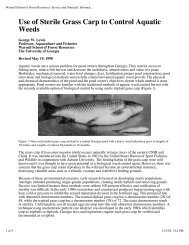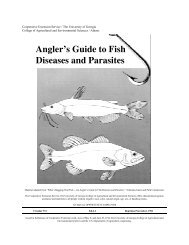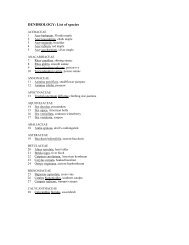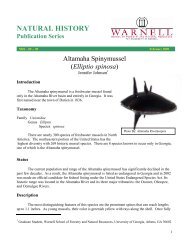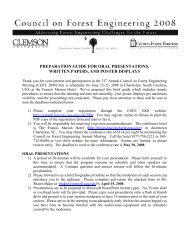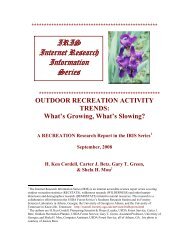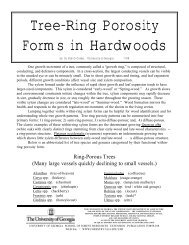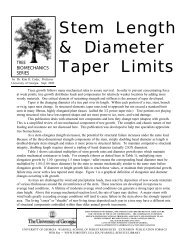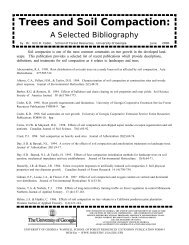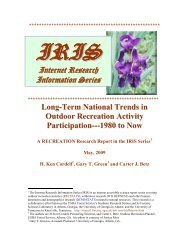Evaluation of two baling systems for harvesting biomass on the ...
Evaluation of two baling systems for harvesting biomass on the ...
Evaluation of two baling systems for harvesting biomass on the ...
Create successful ePaper yourself
Turn your PDF publications into a flip-book with our unique Google optimized e-Paper software.
31 st Annual Council <strong>on</strong> Forest Engineering Meeting (COFE 2008)<br />
<str<strong>on</strong>g>Evaluati<strong>on</strong></str<strong>on</strong>g> <str<strong>on</strong>g>of</str<strong>on</strong>g> <str<strong>on</strong>g>two</str<strong>on</strong>g> <str<strong>on</strong>g>baling</str<strong>on</strong>g> <str<strong>on</strong>g>systems</str<strong>on</strong>g> <str<strong>on</strong>g>for</str<strong>on</strong>g><br />
<str<strong>on</strong>g>harvesting</str<strong>on</strong>g> <str<strong>on</strong>g>biomass</str<strong>on</strong>g> <strong>on</strong> <strong>the</strong> Osceola Nati<strong>on</strong>al<br />
Forest, Florida, United States<br />
Juliana Canto<br />
Visiting Ph.D. Student<br />
USDA Forest Service<br />
Sou<strong>the</strong>rn Research Stati<strong>on</strong><br />
Auburn, AL
1. Introducti<strong>on</strong><br />
This study was developed in <strong>the</strong> Osceola Nati<strong>on</strong>al Forest (near Lake City), Florida
1. Introducti<strong>on</strong><br />
This study was developed in <strong>the</strong> Osceola Nati<strong>on</strong>al Forest (near Lake City), Florida<br />
To achieve <strong>the</strong> DISERED CONDITION <strong>on</strong> pine fla<str<strong>on</strong>g>two</str<strong>on</strong>g>ods,<br />
(open stand with a low shrub layer and a rich herbaceous ground cover)<br />
managers have implemented: thinning, prescribed burning, l<strong>on</strong>gleaf restorati<strong>on</strong>…<br />
However, <strong>the</strong> prescribed fire yearly target (30,000 acres) <strong>on</strong> <strong>the</strong> ONF has not been<br />
reached due to unfavorable wea<strong>the</strong>r c<strong>on</strong>diti<strong>on</strong>s in c<strong>on</strong>cert with heavy fuel loading<br />
from a lack <str<strong>on</strong>g>of</str<strong>on</strong>g> historic burning and smoke management (I-10 bisects <strong>the</strong> <str<strong>on</strong>g>for</str<strong>on</strong>g>est).
1. Introducti<strong>on</strong><br />
So, <strong>the</strong> removal <str<strong>on</strong>g>of</str<strong>on</strong>g> <strong>the</strong> excessive fuel loading would reduce <strong>the</strong> risk <str<strong>on</strong>g>of</str<strong>on</strong>g> catastrophic<br />
wildfire, facilitate <strong>the</strong> reintroducti<strong>on</strong> <str<strong>on</strong>g>of</str<strong>on</strong>g> prescribed fire across a larger landscape and<br />
improve wildlife habitat.<br />
Besides <strong>the</strong> FIRE FUEL REDUCTION and <strong>the</strong> FOREST HEALTH IMPROVEMENT,<br />
benefits <str<strong>on</strong>g>of</str<strong>on</strong>g> <str<strong>on</strong>g>harvesting</str<strong>on</strong>g> <str<strong>on</strong>g>biomass</str<strong>on</strong>g> may include<br />
ENERGY PRODUCTION
2. Materials & Methods<br />
2.1. Area<br />
3 different sites – stands with slash and l<strong>on</strong>gleaf pine<br />
Prior to <strong>the</strong> machine evaluati<strong>on</strong>, an understory survey was d<strong>on</strong>e <strong>on</strong> each<br />
site to determine <str<strong>on</strong>g>biomass</str<strong>on</strong>g> levels per area and species compositi<strong>on</strong>
2. Materials & Methods<br />
Pre-treatment <str<strong>on</strong>g>biomass</str<strong>on</strong>g> levels in green t<strong>on</strong>s per acre <str<strong>on</strong>g>for</str<strong>on</strong>g> <strong>the</strong> three study sites.<br />
Pine<br />
Site Shrubs 1 Dbh < 1-inch 1 ≤ Dbh ≤ 5.5<br />
Maple 2 Wax myrtle 3 Total<br />
1 7.24 0.0 0.14 0.0 0.0 7.38<br />
2 7.42 0.0 0.78 0.10 0.02 8.32<br />
3 – Block 1 5.66 4.03 28.92 0.0 0.30 38.91<br />
3 – Block 2 10.29 2.07 9.98 0.0 0.61 22.95<br />
1<br />
Includes palmetto, gall berry, bay and wax myrtle with Dbh < 1-inch.<br />
2<br />
Sizes ranged from 1.1 to 2.1 inches Dbh.<br />
3<br />
Stems with 1-inch Dbh and larger.
2. Materials & Methods<br />
98%<br />
Pine<br />
Site Shrubs 1 Dbh < 1-inch 1 ≤ Dbh ≤ 5.5<br />
Maple 2 Wax myrtle 3 Total<br />
1 7.24 0.0 0.14 0.0 0.0 7.38<br />
2 7.42 0.0 0.78 0.10 0.02 8.32<br />
3 – Block 1 5.66 4.03 28.92 0.0 0.30 38.91<br />
3 – Block 2 10.29 2.07 9.98 0.0 0.61 22.95<br />
1<br />
Includes palmetto, gall berry, bay and wax myrtle with Dbh < 1-inch.<br />
2<br />
Sizes ranged from 1.1 to 2.1 inches Dbh.<br />
3<br />
Stems with 1-inch Dbh and larger.<br />
Site 1<br />
17.5 trees/acre<br />
12.2 ft 2 /acre
2. Materials & Methods<br />
89%<br />
Pine<br />
Site Shrubs 1 Dbh < 1-inch 1 ≤ Dbh ≤ 5.5<br />
Maple 2 Wax myrtle 3 Total<br />
1 7.24 0.0 0.14 0.0 0.0 7.38<br />
2 7.42 0.0 0.78 0.10 0.02 8.32<br />
3 – Block 1 5.66 4.03 28.92 0.0 0.30 38.91<br />
3 – Block 2 10.29 2.07 9.98 0.0 0.61 22.95<br />
1<br />
Includes palmetto, gall berry, bay and wax myrtle with Dbh < 1-inch.<br />
2<br />
Sizes ranged from 1.1 to 2.1 inches Dbh.<br />
3<br />
Stems with 1-inch Dbh and larger.<br />
Site 2<br />
85 trees/acre<br />
59.1 ft 2 /acre
2. Materials & Methods<br />
15% 10%<br />
74%<br />
Pine<br />
Site Shrubs 1 Dbh < 1-inch 1 ≤ Dbh ≤ 5.5<br />
Maple 2 Wax myrtle 3 Total<br />
1 7.24 0.0 0.14 0.0 0.0 7.38<br />
2 7.42 0.0 0.78 0.10 0.02 8.32<br />
3 – Block 1 5.66 4.03 28.92 0.0 0.30 38.91<br />
3 – Block 2 10.29 2.07 9.98 0.0 0.61 22.95<br />
1<br />
Includes palmetto, gall berry, bay and wax myrtle with Dbh < 1-inch.<br />
2<br />
Sizes ranged from 1.1 to 2.1 inches Dbh.<br />
3<br />
Stems with 1-inch Dbh and larger.<br />
Site 3 – Block 1<br />
Shelterwood stand with 9.7 trees/acre<br />
<str<strong>on</strong>g>of</str<strong>on</strong>g> slash pine overstory and<br />
a very dense midstory
2. Materials & Methods<br />
45%<br />
43%<br />
Pine<br />
Site Shrubs 1 Dbh < 1-inch 1 ≤ Dbh ≤ 5.5<br />
Maple 2 Wax myrtle 3 Total<br />
1 7.24 0.0 0.14 0.0 0.0 7.38<br />
2 7.42 0.0 0.78 0.10 0.02 8.32<br />
3 – Block 1 5.66 4.03 28.92 0.0 0.30 38.91<br />
3 – Block 2 10.29 2.07 9.98 0.0 0.61 22.95<br />
1<br />
Includes palmetto, gall berry, bay and wax myrtle with Dbh < 1-inch.<br />
2<br />
Sizes ranged from 1.1 to 2.1 inches Dbh.<br />
3<br />
Stems with 1-inch Dbh and larger.<br />
Site 3 – Block 2<br />
Shelterwood stand with 9.7 trees/acre<br />
<str<strong>on</strong>g>of</str<strong>on</strong>g> slash pine overstory and<br />
a very dense midstory
2. Materials & Methods<br />
2.2. Systems<br />
Bio-baler & Cat Challenger MT565B tractor<br />
• Bio-baler (cutter-shredder-baler prototype)<br />
Developed by Agriculture and Agri-Food Canada & Université Laval, QC<br />
Commercial round baler (New Holland BR740) as <strong>the</strong> harvest plat<str<strong>on</strong>g>for</str<strong>on</strong>g>m<br />
20 flail hammers combining cutting and shredding functi<strong>on</strong>s<br />
• 145-hp Caterpillar Challenger MT565B tractor
2. Materials & Methods<br />
2.2. Systems<br />
Claas baler & Cat Challenger MT545B tractor + Supertrak mulcher<br />
1 st operati<strong>on</strong><br />
cutting and shredding<br />
• 140-hp Supertrak tractor (SK 140 TR) &<br />
Fec<strong>on</strong> head (BH-74 SS) 30 chipper teeth<br />
• 300-hp Supertrak tractor (SK 300 TR) &<br />
Fec<strong>on</strong> head (BH-120) 48 carbide teeth
2. Materials & Methods<br />
2.2. Systems<br />
Claas baler & Cat Challenger MT545B tractor + Supertrak mulcher<br />
2 nd<br />
nd operati<strong>on</strong><br />
<str<strong>on</strong>g>baling</str<strong>on</strong>g><br />
• Claas Rollant 250<br />
• 120-hp Caterpillar Challenger MT545B tractor
2. Materials & Methods<br />
2.3. Data collecti<strong>on</strong><br />
• Time study<br />
- machines were timed<br />
- activity recorders were used to collect some data<br />
• Distances and areas<br />
• Bale measurements<br />
- distance measuring wheel<br />
-GPS<br />
- dimensi<strong>on</strong>s were measured with a tape<br />
- weights were measured with a hanging dial scale
2. Materials & Methods<br />
2.3. Data collecti<strong>on</strong><br />
• Time study<br />
- machines were timed<br />
- activity recorders were used to collect some data<br />
• Distances and areas<br />
• Bale measurements<br />
- distance measuring wheel<br />
-GPS<br />
- dimensi<strong>on</strong>s were measured with a tape<br />
- weights were measured with a hanging dial scale<br />
• Fuel c<strong>on</strong>sumpti<strong>on</strong><br />
- using a metered refueling tank<br />
• Cost estimates - machine rate approach described by Miyata (1980)
3. Results<br />
3.1. System per<str<strong>on</strong>g>for</str<strong>on</strong>g>mance<br />
Site 1 and Site 2<br />
Bio-baler & MT565B<br />
Claas baler & MT545B<br />
Site 1 2 1 2<br />
Time per bale (min) 15.30 13.50 6.20 6.84<br />
Bales per hour 3.92 4.44 9.68 8.78<br />
Acres/h 1.03 0.73 1.77 1.27<br />
Green t<strong>on</strong>s per productive hour 2.22 2.62 6.69 5.52<br />
Green t<strong>on</strong>s per acre 2.15 3.59 3.77 4.35<br />
Fracti<strong>on</strong> <str<strong>on</strong>g>of</str<strong>on</strong>g> understory harvested 0.29 0.43 0.51 0.52
3. Results<br />
3.1. System per<str<strong>on</strong>g>for</str<strong>on</strong>g>mance<br />
Site 1 and Site 2<br />
Bio-baler & MT565B<br />
Claas baler & MT545B<br />
Site 1 2 1 2<br />
Time per bale (min) 15.30 13.50 6.20 6.84<br />
Bales per hour 3.92 4.44 9.68 8.78<br />
Acres/h 1.03 0.73 1.77 1.27<br />
Green t<strong>on</strong>s per productive hour 2.22 2.62 6.69 5.52<br />
Green t<strong>on</strong>s per acre 2.15 3.59 3.77 4.35<br />
Fracti<strong>on</strong> <str<strong>on</strong>g>of</str<strong>on</strong>g> understory harvested 0.29 0.43 0.51 0.52
3. Results<br />
3.1. System per<str<strong>on</strong>g>for</str<strong>on</strong>g>mance<br />
Site 1 and Site 2<br />
Bio-baler & MT565B<br />
Claas baler & MT545B<br />
Site 1 2 1 2<br />
Time per bale (min) 15.30 13.50 6.20 6.84<br />
Bales per hour 3.92 4.44 9.68 8.78<br />
Acres/h 1.03 0.73 1.77 1.27<br />
Green t<strong>on</strong>s per productive hour 2.22 2.62 6.69 5.52<br />
Green t<strong>on</strong>s per acre 2.15 3.59 3.77 4.35<br />
Fracti<strong>on</strong> <str<strong>on</strong>g>of</str<strong>on</strong>g> understory harvested 0.29 0.43 0.51 0.52
3. Results<br />
3.1. System per<str<strong>on</strong>g>for</str<strong>on</strong>g>mance<br />
SK 140 SK 300<br />
Site 1 2 1 2<br />
Acres/h 0.74 1.08 * 0.89<br />
* SK 300 mulcher was not evaluated <strong>on</strong> Site 1.<br />
Site 1 and Site 2
3. Results<br />
3.1. System per<str<strong>on</strong>g>for</str<strong>on</strong>g>mance<br />
Site 3 – Block 2<br />
Claas baler & MT545B *<br />
No. <str<strong>on</strong>g>of</str<strong>on</strong>g> passes (SK 140) 1 2<br />
Time per bale (min) 25.8 11.4<br />
Bales per hour 2.3 5.3<br />
Acres/h 0.37 0.79<br />
Green t<strong>on</strong>s per productive hour 1.61 4.19<br />
Green t<strong>on</strong>s per acre 4.32 5.31<br />
Fracti<strong>on</strong> <str<strong>on</strong>g>of</str<strong>on</strong>g> understory harvested 0.19 0.23<br />
* The Bio-baler did not attempt to work <strong>on</strong> Site 3.
3. Results<br />
3.1. System per<str<strong>on</strong>g>for</str<strong>on</strong>g>mance<br />
Site 3<br />
SK 140 <strong>on</strong> Block 2 SK 300 <strong>on</strong> Block 1<br />
No. <str<strong>on</strong>g>of</str<strong>on</strong>g> passes 1 2 1 2<br />
Acres/h 0.69 0.41 0.82 *<br />
* SK 300 mulcher was not evaluated making <str<strong>on</strong>g>two</str<strong>on</strong>g> passes.
3. Results<br />
3.2. Fuel c<strong>on</strong>sumpti<strong>on</strong><br />
Site 1 and Site 2<br />
SK 140 SK 300<br />
Bio-baler &<br />
MT565B<br />
Claas baler &<br />
MT545B<br />
Rate per operati<strong>on</strong> (gal/h) 3.89 5.39 3.62 3.94<br />
Specific rate (gal/hp-h) 0.0278 0.0180 0.0250 0.0328<br />
Fuel per unit harvest (gal/t) 1.06 1.51 1.50 0.64<br />
Mulcher & Claas baler (gal/t) 1.71 2.15
3. Results<br />
3.2. Fuel c<strong>on</strong>sumpti<strong>on</strong><br />
Site 1 and Site 2<br />
SK 140 SK 300<br />
Bio-baler &<br />
MT565B<br />
Claas baler &<br />
MT545B<br />
Rate per operati<strong>on</strong> (gal/h) 3.89 5.39 3.62 3.94<br />
Specific rate (gal/hp-h) 0.0278 0.0180 0.0250 0.0328<br />
Fuel per unit harvest (gal/t) 1.06 1.51 1.50 0.64<br />
Mulcher & Claas baler (gal/t) 1.71 2.15
3. Results<br />
3.3. Bale measurements<br />
Bio-baler<br />
Claas baler<br />
Site 1 2 3 1 2 3<br />
Size (ft 3 )* 61.5 58.9 - 57.6 54.1 52.8<br />
Weight (green lb)* 1130.9 1180.4 - 1383.2 1258.5 1499.5<br />
Density (green lb/ ft 3 )* 18.4 20.0 - 24.0 23.3 28.4<br />
* Average.
3. Results<br />
3.4. Costs and benefits<br />
Costs* and benefits (<str<strong>on</strong>g>biomass</str<strong>on</strong>g> harvested, percentage <str<strong>on</strong>g>of</str<strong>on</strong>g> understory recovered)<br />
from mechanical <str<strong>on</strong>g>harvesting</str<strong>on</strong>g>.<br />
System<br />
Cost<br />
($/ac)<br />
Site 1 Site 2 Site 3<br />
H 1<br />
(t/ac)<br />
R 2<br />
(%)<br />
Cost<br />
($/ac)<br />
H 1<br />
(t/ac)<br />
R 2<br />
(%)<br />
Cost<br />
($/ac)<br />
H 1<br />
(t/ac)<br />
Bio-baler 93.10 2.15 29.1 131.88 3.59 43.1 - - -<br />
SK 140 (1 pass)<br />
& Claas baler<br />
SK 140 (2 passes)<br />
& Claas baler<br />
R 2<br />
(%)<br />
169.92 3.77 51.1 148.44 4.35 52.3 339.38 4.32 18.8<br />
- - - - - - 322.47 5.31 23.2<br />
*Costs <str<strong>on</strong>g>for</str<strong>on</strong>g> mulcher-baler system assume independent operati<strong>on</strong> <str<strong>on</strong>g>of</str<strong>on</strong>g> <strong>the</strong> mulcher and <strong>the</strong> baler. O<strong>the</strong>rwise,<br />
costs <str<strong>on</strong>g>of</str<strong>on</strong>g> 169.92, 148.44, 339.38 and 322.47 could be as high as 233.86, 159.66, 453.95 and 414.72 ($/ac),<br />
respectively. 1 Harvest. 2 Recovery.
3. Results<br />
3.4. Costs and benefits<br />
System costs per unit by site.<br />
System<br />
Site 1 Site 2 Site 3<br />
$/bale $/t<strong>on</strong> $/bale $/t<strong>on</strong> $/bale $/t<strong>on</strong><br />
Bio-baler 24.43 43.30 21.66 36.74 - -<br />
SK 140 (1 pass) & Claas baler 31.18 45.07 21.48 34.12 54.30 78.56<br />
SK 140 (2 passes) & Claas baler - - - - 51.60 74.65<br />
SK 300 (1 pass) & Claas baler - - 34.87 55.39 59.84 75.17
3. Results<br />
3.4. Costs and benefits<br />
System costs per unit by site.<br />
System<br />
Site 1 Site 2 Site 3<br />
$/bale $/t<strong>on</strong> $/bale $/t<strong>on</strong> $/bale $/t<strong>on</strong><br />
Bio-baler 24.43 43.30 21.66 36.74 - -<br />
SK 140 (1 pass) & Claas baler 31.18 45.07 21.48 34.12 54.30 78.56<br />
SK 140 (2 passes) & Claas baler - - - - 51.60 74.65<br />
SK 300 (1 pass) & Claas baler - - 34.87 55.39 59.84 75.17
3. Results<br />
3.4. Costs and benefits<br />
System costs per unit by site.<br />
System<br />
Site 1 Site 2 Site 3<br />
$/bale $/t<strong>on</strong> $/bale $/t<strong>on</strong> $/bale $/t<strong>on</strong><br />
Bio-baler 24.43 43.30 21.66 36.74 - -<br />
SK 140 (1 pass) & Claas baler 31.18 45.07 21.48 34.12 54.30 78.56<br />
SK 140 (2 passes) & Claas baler - - - - 51.60 74.65<br />
SK 300 (1 pass) & Claas baler - - 34.87 55.39 59.84 75.17
4. C<strong>on</strong>clusi<strong>on</strong><br />
Bio-baler system<br />
has <strong>the</strong> advantage <str<strong>on</strong>g>of</str<strong>on</strong>g> per<str<strong>on</strong>g>for</str<strong>on</strong>g>ming <strong>the</strong> cutting, shredding and <str<strong>on</strong>g>baling</str<strong>on</strong>g> with <strong>on</strong>e machine;<br />
has lower purchase price and fuel c<strong>on</strong>sumpti<strong>on</strong> rate and → lower cost per acre;<br />
was less productive and encountered limitati<strong>on</strong>s to work <strong>on</strong> <strong>the</strong> densest site;<br />
recovered lower amount <str<strong>on</strong>g>of</str<strong>on</strong>g> <str<strong>on</strong>g>biomass</str<strong>on</strong>g> per area.<br />
Mulcher – Claas baler system<br />
has higher purchase price and fuel c<strong>on</strong>sumpti<strong>on</strong> rate → higher cost per acre.<br />
Assuming this system would operate very efficiently (no idling time t<br />
<str<strong>on</strong>g>of</str<strong>on</strong>g> <strong>the</strong> faster<br />
unit operati<strong>on</strong> which would work at o<strong>the</strong>r chores when <strong>the</strong> o<strong>the</strong>r unit u<br />
operati<strong>on</strong><br />
lagged), cost per t<strong>on</strong> would likely be slightly higher.
Thank you!



